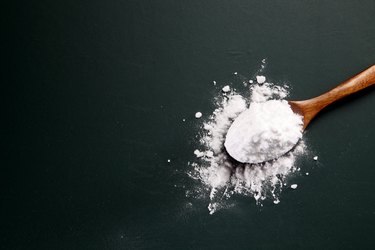
If you like to bake, no doubt there's a box of sodium bicarbonate — better known as baking soda — in your kitchen cupboard. Though its leavening powers can help you work magic with dough, baking soda is high in sodium, and that could affect your blood pressure.
The Pluses of Baking Soda
Video of the Day
Baking soda is actually a molecular mixture of sodium, hydrogen and oxygen, according to the American Chemical Society's ChemicalSafetyFacts.org (CSF). It's fancied by chefs as an additive ingredient that promotes the expansion and rising of baked goods like cakes and breads. Just a couple of teaspoons of the powder are often added to a batter mixture.
Video of the Day
Baking soda also provides useful health benefits. For example, the U.S. National Library of Medicine notes that it can serve as a heartburn remedy by virtue of its ability to neutralize stomach acid. (It's the main ingredient in Alka-Seltzer.) It also has the capacity to help remove tooth stains and thereby whiten teeth, according to CSF.
In addition, the American Heart Association (AHA) underscores the fact that sodium is an essential mineral that helps balance your bodily fluids, while facilitating the function of your muscles and nervous system.
A Drawback of Baking Soda
Despite the benefits, there's a potential downside too. When you consume baking soda, "the excess salt retention can raise blood pressure levels," warns Gregg Fonarow, MD, director of the Ahmanson-UCLA Cardiomyopathy Center and codirector of the UCLA Preventative Cardiology Program.
And with baking soda, the amount of excess salt can be considerable. The AHA notes that just a single teaspoon of baking soda contains about 1,000 milligrams of sodium. In essence that's a lot of "secret" sodium: It's not something you have control of, like the salt shaker on your table.
Food manufacturers often add sodium, either as salt or some form of salt, like baking soda, to processed, packaged and restaurant foods, according to the AHA. Those sources contribute to the more than 70 percent of sodium people consume, it says. That's before anyone reaches for the salt shaker.
But, if you add in all that table salt as well, the end result is that Americans consume way too much salt. The AHA recommends that adults limit their sodium intake to no more than 2,300 milligrams a day, with the ideal goal being 1,500. But in reality, on a daily basis, the average American now consumes roughly 3,400 milligrams of sodium.
How This Affects Your Health
As Dr. Fonarow and the AHA explain, when there's excess sodium in your bloodstream, it ends up pulling more water into your blood vessels. In turn, that boosts the amount of blood moving through your blood vessels, and that ultimately drives up your blood pressure. The result? High blood pressure can lead to all kinds of cardiovascular issues, including a heart attack or stroke.
All told, baking soda is not a particularly healthy food item, especially for people already struggling to keep their blood pressure under control, suggests a September 2013 case study and review in the_ Journal of Medical Toxicology_. According to the authors, case reports of baking soda toxicity often involve its use as an antacid, which can lead to heart problems, such as faster-than-normal heart rate.
What to Do
For anyone concerned about their blood pressure, the AHA says that the simple answer is to cut down your overall salt intake. Start by cutting back on salt- and baking soda-laden processed and prepackaged foods.
That means avoiding what AHA researchers call the "Salty 6," meaning the most commonly consumed foods that add sodium to your diet. That list includes:
- Breads and rolls
- Pizza
- Sandwiches
- Cold cuts and cured meats
- Soups
- Burritos and tacos
To keep your blood pressure in check, the Department of Health and Human Services advises paying close attention to packaged food labels. That means first looking out for the number noted under the "sodium" content category, which with processed items often means baking soda. Then check the serving size number. By multiplying those two numbers together, you'll know exactly how much sodium is actually in the entire package.
- Gregg Fonarow, MD, director, Ahmanson-UCLA Cardiomyopathy Center; codirector, UCLA Preventative Cardiology Program, Los Angeles
- ChemicalSafetyFacts.org: "Sodium Bicarbonate (Baking Soda)"
- U.S. National Library of Medicine: "Sodium Bicarbonate"
- American Heart Association: "Sodium Sources: Why Should I Limit Sodium?"
- American Heart Association: "Sodium Sources: Where Does All That Sodium Come From?"
- Department of Health and Human Services: "Your Guide to Lowering Blood Pressure"
- Journal of Medical Toxicology: "Baking Soda Can Settle the Stomach but Upset the Heart: Case Files of the Medical Toxicology Fellowship at the University of California, San Francisco"
Is this an emergency? If you are experiencing serious medical symptoms, please see the National Library of Medicine’s list of signs you need emergency medical attention or call 911.